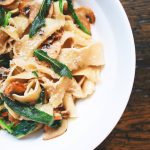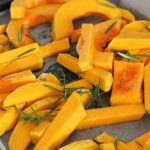Get The Most Out of Your Sage from Backyard Eats
Harvesting Sage
When It’s Ready
- Harvest individual leaves as often as desired, once the plant has been established.
- In the second year, cut down stems leaving 6” on the plant.
- April – December
How To
- Use a sharp knife or shears to clip stems and leaves away from the bush.
About Mediterranean Herbs
Mediterranean herbs are plants that grow 0.5-3 ft tall. They require partial to full sun to thrive, but not trellising or pruning.
Flowering/Fruiting Tendencies
Mediterranean herbs are easy, multi-harvest plants for fresh use, drying, teas, and medicines. Most are typically easy to establish and just need seasonal clean-ups.
Design Notes
Space herbs about 18″ apart. Most are Mediterranean herbs don’t do well in super cold or moist soil. Will overwinter better in warm conditions.
Care Notes
Kitchen herbs benefit from compost. Mulching can be kept to a minimum as many kitchen herbs won’t benefit from the extra moisture retention. Kitchen herbs can typically be thinned/harvested in the summer and fall to keep them from growing wild. Many will get unwieldy and less productive after a few years and may need to be replaced.
Newly planted perennials require some additional care to help establish and support the plants as they grow. Water newly planted perennials deeply at the root 2-3 times a week during the first growing season. Apply compost and wood chip mulch in the late winter/early spring.
Storing Sage
Fresh Storage: Keep in a dark, cool, and dry place for continual use after harvesting.
Long-Term Storage: “Woody” perennial herbs like sage can be dried at home to enjoy all year long! First, trim stems from the main plant. Tie 3-5 stems together into a bundle, then hang them to dry in a cool, dark, and well-ventilated place for 2-3 weeks.
Once the herbs are dry and brittle, you can store and enjoy them long-term.

Cooking With Sage
- Sage Butter: Mix softened butter with finely chopped sage leaves, minced garlic, salt, and pepper. Use the sage butter to top grilled meats, roasted vegetables, or spread it on warm bread for a flavorful and aromatic twist.
- Butternut Squash and Sage Risotto: Sauté minced sage leaves with onions and garlic, then add Arborio rice and butternut squash cubes. Gradually add vegetable broth and stir until the rice is creamy and cooked. The earthy flavor of sage complements the sweetness of butternut squash in this comforting risotto.
- Sage-Roasted Chicken: Rub chicken with olive oil, minced sage leaves, salt, and pepper before roasting. The fragrant sage adds a savory and herbaceous flavor to the chicken as it cooks.
- Sage and Mushroom Pasta: Sauté sliced mushrooms with minced sage leaves, garlic, and olive oil. Toss the mushroom mixture with cooked pasta and sprinkle with grated Parmesan cheese for a simple yet flavorful pasta dish.
- Fried Sage Leaves: Heat oil in a pan and fry whole sage leaves until they turn crispy. Sprinkle the fried sage leaves with salt and use them as a flavorful and crispy garnish for soups, salads, or pasta dishes.




